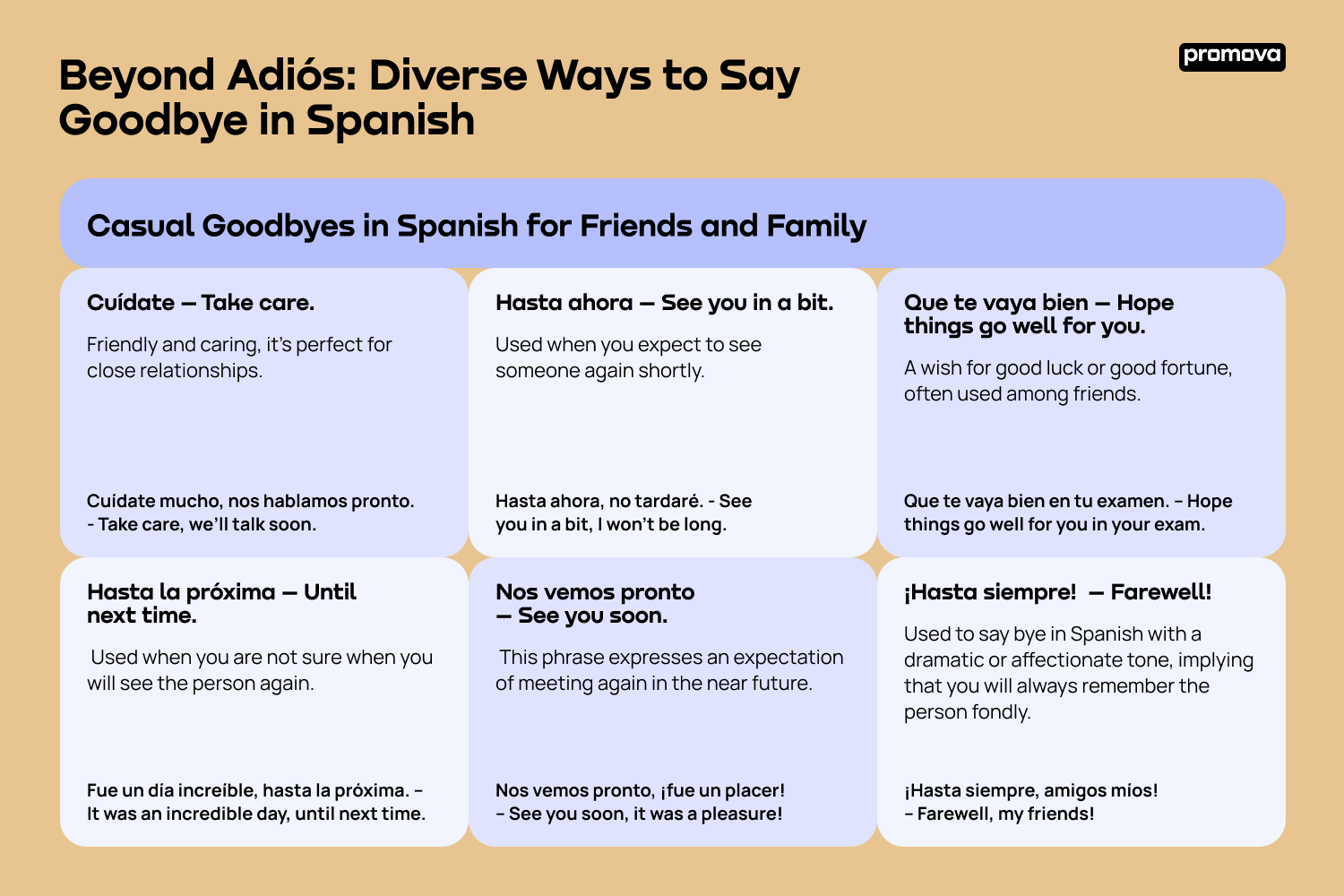Beyond Adiós: Diverse Ways to Say Goodbye in Spanish

Contents
Traveling to a Spanish-speaking country? Meeting new friends? Or simply want to learn the Spanish language? In these situations, you may need to say goodbye in Spanish. This phrase seems straightforward, but there are a lot of options to express it. From casual chats to formal events, the choice of words matters. This article looks at different ways to say bye. You’ll soon feel more confident and at ease in various social situations.
The Most Common Ways to Say Goodbye in Spanish
When parting ways, you’ll find several basic options to say goodbye. Adiós [aˈðjos] is among the most common words for beginners, but it’s not the only word. Let’s look at how to say bye in Spanish:
- Adiós [aˈðjos] – Goodbye. It is the most universal way to say goodbye and is suitable for almost any situation.
Adiós, nos vemos mañana. [aˈðjos, nos ˈβemos maˈɲana] – Goodbye, see you tomorrow.
- Buenas noches [ˈβwenas ˈnotʃes] – Good night. Appropriate when parting ways in the evening or before going to bed.
Buenas noches, que duermas bien. [ˈβwenas ˈnotʃes, ke ˈdwerˈmas ˈβjen] – Good night, sleep well.
- Hasta luego [ˈasta ˈlweɣo] – See you later. Use see you later Spanish when you expect to see the person again soon.
Hasta luego, cuidate mucho. [ˈasta ˈlweɣo, kwiˈðate ˈmutʃo] – See you later, take good care of yourself.
- Nos vemos [nos ˈβemos] – See you. A casual way to say goodbye, implying you will see each other again.
Nos vemos en la próxima clase. [nos ˈβemos en la ˈpɾoksima ˈklase] – See you in the next class.
- Chao [tʃao] – Bye. A very informal and friendly way to say goodbye.
Chao, que te vaya bien. [tʃao, ke te ˈβaʝa ˈβjen] – Bye, hope things go well for you.
- Hasta mañana [ˈasta maˈɲana] – See you tomorrow. Ideal when you know you will see the person the following day.
Hasta mañana, descansa. [ˈasta maˈɲana, desˈkansa] – See you tomorrow, get some rest.
- Hasta el próximo encuentro [ˈasta el ˈpɾoksimo enˈkwentɾo] – Until our next meeting. Suitable for formal and business settings when confirming a future meeting.
Hasta el próximo encuentro, será un placer volver a verlos. [ˈasta el ˈpɾoksimo enˈkwentɾo, seˈɾa un plaˈθeɾ ˈβolβeɾ a ˈβeɾlos] – Until our next meeting, it will be a pleasure to see you all again.
How to Say Goodbye in Spanish Formal Situations
A formal goodbye is more appropriate in certain settings. Professional meetings, business events, or formal gatherings often call for more polished word choices. The right phrases show respect and knowledge of cultural norms. Here are 8 ways to say goodbye in Spanish formal contexts:
- Hasta pronto [ˈasta ˈpɾonto] – See you soon. Expresses the hope of seeing someone again in the near future.
Espero que podamos colaborar de nuevo, hasta pronto. [esˈpeɾo ke poˈðamos kolaβoˈɾaɾ ðe ˈnweβo, ˈasta ˈpɾonto] – I hope we can collaborate again, see you soon.
- Que tenga un buen día [ke ˈteŋɡa un bwen ˈdi.a] – Have a good day. A courteous way to wish someone well at the end of a conversation.
Gracias por su tiempo, que tenga un buen día. [ˈɡɾasjas poɾ su ˈtjempo, ke ˈteŋɡa un bwen ˈdi.a] – Thank you for your time, have a good day.
- Hasta la próxima [ˈasta la ˈpɾoksima] – Until next time. This farewell in Spanish implies an expectation of meeting again in the future.
Ha sido un placer, hasta la próxima. [a siˈðo un plaˈθeɾ, ˈasta la ˈpɾoksima] – It has been a pleasure, until next time.
- Le deseo lo mejor [le ðeˈseo lo meˈxoɾ] – I wish you the best. A phrase that conveys good wishes and positivity.
Ha sido un excelente proyecto, le deseo lo mejor. [a siˈðo un eksθeˈlente pɾoˈʝekto, le ðeˈseo lo meˈxoɾ] – It has been an excellent project, I wish you the best.
- Espero que volvamos a vernos [esˈpeɾo ke bolˈβamos a ˈbeɾnos] – I hope we meet again. Expresses a polite desire to see the person again.
Gracias por la reunión, espero que volvamos a vernos. [ˈɡɾasjas poɾ la reuˈnjon, esˈpeɾo ke bolˈβamos a ˈbeɾnos] – Thank you for the meeting, I hope we meet again.
- Cuídese mucho [kwiˈðese ˈmutʃo] – Take good care of yourself. A considerate and caring way to say goodbye in Spanish.
Fue un honor trabajar con usted, cuídese mucho. [fwe un oˈnoɾ tɾaβaˈxaɾ kon usˈteð, kwiˈðese ˈmutʃo] – It was an honor to work with you, take good care of yourself.
- Agradezco su colaboración [aɣɾaˈðesko su kolaβoɾaˈθjon] – I appreciate your cooperation. This phrase is often used to end formal meetings or collaborations.
Agradezco su colaboración en este proyecto. [aɣɾaˈðesko su kolaβoɾaˈθjon en ˈeste pɾoˈʝekto] – I appreciate your cooperation in this project.
- Nos vemos en la próxima reunión [nos ˈβemos en la ˈpɾoksima reuˈnjon] – See you at the next meeting. Perfect for concluding professional gatherings.
Ha sido productivo, nos vemos en la próxima reunión. [a siˈðo pɾoðukˈtiβo, nos ˈβemos en la ˈpɾoksima reuˈnjon] – It has been productive, see you at the next meeting.
1
Casual Goodbyes in Spanish for Friends and Family
We often use more relaxed expressions when talking to friends or family. Casual farewells add warmth and a personal touch to your daily chats. They’re easy to learn and fun to use. Let’s look at the friendly and heartfelt ways to say goodbye in Spanish:
- Cuídate [kwiˈðate] – Take care. Friendly and caring, it’s perfect for close relationships.
Cuídate mucho, nos hablamos pronto. [kwiˈðate ˈmutʃo, nos aˈβlamos ˈpɾonto] – Take care, we’ll talk soon.
- Hasta ahora [ˈasta aˈoɾa] – See you in a bit. Used when you expect to see someone again shortly.
Hasta ahora, no tardaré. [ˈasta aˈoɾa, no tarˈðaɾe] – See you in a bit, I won’t be long.
- Que te vaya bien [ke te ˈβaʝa ˈβjen] – Hope things go well for you. A wish for good luck or good fortune, often used among friends.
Que te vaya bien en tu examen. [ke te ˈβaʝa ˈβjen en tu eksaˈmen] – Hope things go well for you in your exam.
- Hasta la próxima [ˈasta la ˈpɾoksima] – Until next time. Used when you are not sure when you will see the person again.
Fue un día increíble, hasta la próxima. [fwe un ˈdja inˈkɾejβle, ˈasta la ˈpɾoksima] – It was an incredible day, until next time.
- Nos vemos pronto [nos ˈβemos ˈpɾonto] – See you soon. This phrase expresses an expectation of meeting again in the near future.
Nos vemos pronto, ¡fue un placer! [nos ˈβemos ˈpɾonto, ˈfwe un plaˈθeɾ] – See you soon, it was a pleasure!
- ¡Hasta siempre! [ˈasta ˈsjem.pɾe] – Farewell! Used to say bye in Spanish with a dramatic or affectionate tone, implying that you will always remember the person fondly.
¡Hasta siempre, amigos míos! [ˈasta ˈsjem.pɾe, aˈmiɣos ˈmjos] – Farewell, my friends!
- Te veo [te ˈβeo] – See you. A very casual and commonly used phrase among friends and family.
Te veo el próximo fin de semana. [te ˈβeo el ˈpɾoksimo fin de seˈmana] – See you next weekend.
- Hasta entonces [ˈasta enˈtonses] – Until then. Use this when you have a specific future date or event in mind for your next meeting.
Hasta entonces, sigue así. [ˈasta enˈtonses, ˈsiɣe aˈsi] – Until then, keep it up.
- Cuídate mucho [kwiˈðate ˈmutʃo] – Take good care of yourself. A caring and affectionate way to part ways, emphasizing good health and well-being.
Fue genial verte, cuídate mucho. [ˈfwe xeˈnjal ˈβeɾte, kwiˈðate ˈmutʃo] – It was great to see you, take good care of yourself.
- Que descanses [ke desˈkanses] – Rest well. Ideal for saying see you later in Spanish in the evening or before a break.
Buenas noches, que descanses. [ˈbwena nɔˈʧes, ke desˈkanses] – Good night, rest well.
- Nos hablamos [nos aˈβlamos] – We’ll talk. This phrase suggests that you will stay in touch, typically via phone or messaging.
Nos hablamos mañana para confirmar. [nos aˈβlamos maˈɲana paɾa konfirˈmaɾ] – We’ll talk tomorrow to confirm.

Spanish Farewells in Letters and Emails
One more situation where you might need Spanish farewells is when writing letters or emails. Whether for business or personal reasons, the right closing words matter. Formal settings require specific phrases, while casual notes allow more relaxed endings. Here’s what is goodbye in Spanish letters and emails:
- Atentamente [a.tenˈta.men.te] – Sincerely. A formal closing, often used in professional correspondence.
Atentamente, Juan Pérez. [a.tenˈta.men.te, xwan ˈpeɾes] – Sincerely, Juan Pérez.
- Saludos cordiales [saˈlu.ðos korˈðja.les] – Kind regards. A polite farewell, suitable for business emails.
Saludos cordiales, Marta García. [saˈlu.ðos korˈðja.les, ˈmaɾta ɣaɾˈθi.a] – Kind regards, Marta García.
- Un abrazo [un aˈβɾa.θo] – A hug. Friendly and warm, perfect for close friends or family.
Un abrazo, Ana. [un aˈβɾa.θo, ˈana] – A hug, Ana.
- Besos [ˈbe.sos] – Kisses. It is used to say goodbye in Spanish informal situations, usually with close friends or loved ones.
Besos, María. [ˈbe.sos, maˈɾi.a] – Kisses, María.
- Con cariño [kon kaˈɾi.ɲo] – With love. Great for personal letters.
Con cariño, tu amiga Clara. [kon kaˈɾi.ɲo, tu aˈmi.ɣa ˈkla.ɾa] – With love, your friend Clara.
- Cordialmente [korðjalˈmen.te] – Cordially. A formal closing, often used in business or official letters.
Cordialmente, Dr. López. [korðjalˈmen.te, do.ktor ˈlo.peθ] – Cordially, Dr. López.
- Que tengas un buen día [ke ˈteŋɡas un bwen ˈdi.a] – Have a good day. Suitable for both formal and informal notes.
Que tengas un buen día, Laura. [ke ˈteŋɡas un bwen ˈdi.a, ˈlawɾa] – Have a good day, Laura.
Learn Languages at Your Own Pace with Promova
Promova helps you learn languages easily and flexiblely. We cover Spanish, English, French, Chinese, and more. Whether you are new or want to get better at these tongues, Promova offers something for everyone.
Short lessons help users study in their free time. Each covers main points, such as new words, phrases used among native speakers, and grammar rules. Real-life examples show how to use the language in daily talks.
Interactive quizzes make learning fun and practical. They test understanding and help users remember what they know. Progress tracking features show improvements over time, allowing you to stay motivated and see which areas need more focus.
If you want to learn English online, one-on-one classes offer personalized support. Tutors adjust lessons to your needs, whether you require help with pronunciation or grammar rules. Group sessions are an option as well. They let everyone practice speaking and listening with people at the same level.
Our mobile app works on Android and iOS devices. It can be accessed anytime, anywhere, fitting well into busy schedules. Download the application today and make progress toward your language goals.
Conclusion
With all these ways to say good bye in Spanish, you can feel more confident in any social or professional setting. Whether you need a formal farewell, a casual goodbye for friends and family, or the perfect closing for a letter, there’s always the right phrase. Practice these expressions and add warmth and respect to your conversations. The effort you put into learning these farewells will pay off in more meaningful connections.
FAQ
Does body language play a role when expressing farewells?
Body language complements your adios in Spanish. A handshake or a hug can bring warmth or formality depending on the situation and the bond with the other person.
How can I respond to someone’s goodbye in Spanish?
The response usually mirrors the farewell given. If someone says hasta luego [ˈasta ˈlweɣo], a similar response works well, such as repeating the phrase back.
How can I practice saying goodbye in Spanish daily?
Integrate these phrases into your day-to-day interactions. You might start using Spanish farewells with friends and family or in any casual scenarios where you normally say goodbye. Frequent use helps improve fluency.
What are some good resources for learning more Spanish phrases?
Whether you learn Spain Spanish or Latin American Spanish, try online dictionaries like WordReference and Linguee. These websites provide translations and example sentences.



Comments